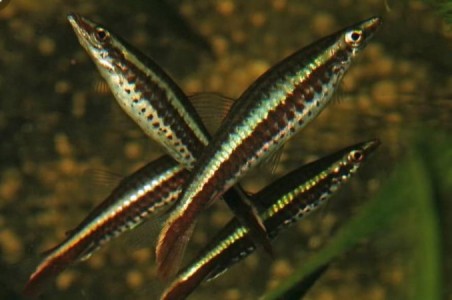- Name:
Diptail Pencilfish
(View AKA's) - Family: Lebiasinidae
- Species: Pencil Fish
- Scientific Name: Nannostomus eques


General info about Diptail Pencilfish
These fish are very slender, they are light gray and have five rows of dark spots on their back and a red and black markings on the anal fin. They can reach up to 2 inches. To keep these fish in captivity, water temperature should range from 73°F to 82°F and water pH should be between 5.0 and 6.0. The tank should be densely planted, it should also have floating vegetation and open areas for swimming. They are peaceful and can be kept in community aquariums with equally peaceful fish, they should be kept in groups of 6.
Diptail Pencilfish Diet & Nutrition
This species is carnivorous. In the wild it feeds on zooplankton and invertebrates. In captivity it can be fed with dried foods supplemented with live foods like small insects, Daphnia, mosquito larvae, Artemia and worms.
Determining Sex of Diptail Pencilfish
Males are thinner and more colorful than females.
Breeding & Spawning Diptail Pencilfish
To breed this species in captivity, the breeding tank should have a 6.0 pH and a water temperature of 86°F. Once the eggs are laid the parents should be removed since they may try to eat them. The eggs take 1 to 2 days to hatch and the fry become free swimming 5 days after.
Diptail Pencilfish Origin
This species is native to the Amazon basin , Columbia and Guyana. It inhabits slow moving waters with dense vegetation.
Original Detail
| Name | Species | Family | Scientific Name | More Detail | Added by |
|---|---|---|---|---|---|
| Diptail Pencilfish | Pencil Fish | Lebiasinidae | Nannostomus eques | These fish are very slender, they are light gray and have five rows of dark spots on their back and a red and black markings on the anal fin. They can reach up to 2 inches. To keep these fish in captivity, water temperature should range from 73°F to 82°F and water pH should be between 5.0 and 6.0. The tank should be densely planted, it should also have floating vegetation and open areas for swimming. They are peaceful and can be kept in community aquariums with equally peaceful fish, they should be kept in groups of 6. |
Admin |
Changed by users
| Submitted Date | Submitted By | Status | Action |
|---|


